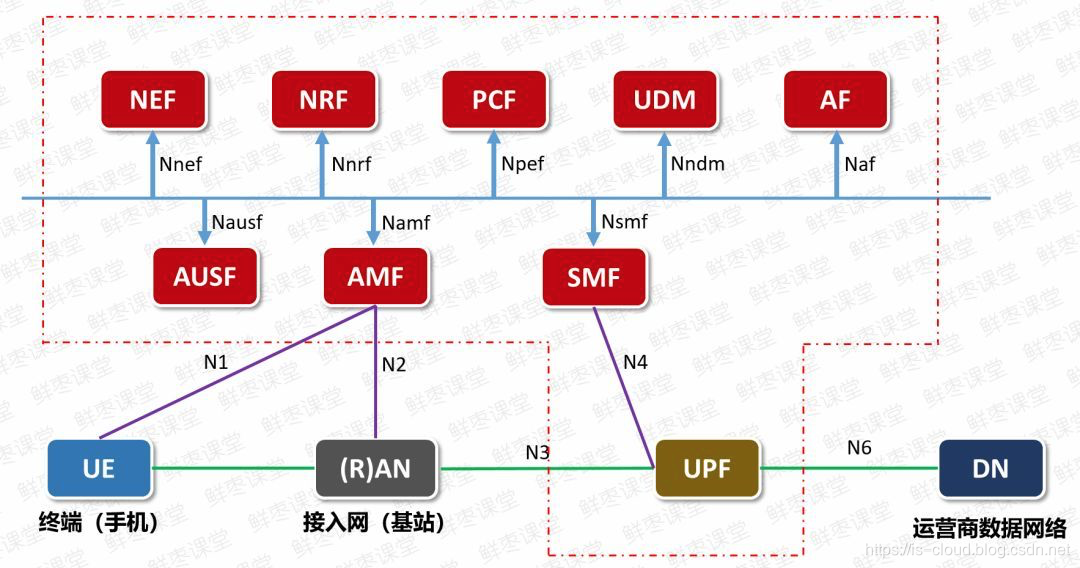5G NGC — UPF 用户面功能
目录
UPF
UPF(User Plane Function,用户面功能):从 4G EPC CUPS 演进而来,4G EPC CUPS 将 SGW/PGW 分离为 SGW/PGW-C 和 SGW/PGW-U,前者负责处理信令业务,而后者则在更接近网络边缘的地方执行 UP 的 SDF(业务数据流)以及流量聚合,达到提高带宽效率,同时减少网络阻塞的效果。然而在 4G 中要彻底实现 CP 和 UP 的分离是一项复杂的工程,5G 则引入了 UPF 来实现这一点。

UPF 的参考点架构

与 UPF 相关的由 4 个标准参考点:
- N3:® AN 和 I-UPF(Initial UPF)/ UPF 之间的接口。
- N4:SMF 和 UPF 之间的接口。
- N6:DN 和 UPF 之间的接口。
- N9:I-UPF 和 PSA 之间的接口。移动场景中,UE 与 PSA 之间插入 I-UPF 进行流量转发。
- N19:两个 PSA 之间的接口。5G LAN 场景中,两个 PSA 之间的用户面接口,在不使用 N6 接口的情况下直接路由不同 PDU Session 之间的流量。

其中,N3 和 N9 参考点上采用了以下协议,由 I-UPF 来完成中继,并在 PSA 上终结:
- 带 5G 扩展协议头的 GTPv1-U 协议。
- 分段路由协议(SRV6 或 NSH)。
- ICN(Information Centric Networking)协议。
- GTPv1-U 协议之上的 LISP-DP(Locator/ID Separation data plane protocol,位置/身份分离数据平面协议)。
- GTPv1-U 协议之上的 ILA(Identifier Locator Addressing,标识符定位寻址)。
NOTE:PSA(UPF of PDU Session Anchor),Anchor(锚点)的概念来自 4G Anchor PGW,是一个记录了 UE Session 的 PGW,连接着 DN。在 4G EPC 中,SGW 是很多且分散的,但 PGW 只会存在于核心网中心机房。无论 UE 如何移动、SGW 如何切换,但 Anchor PGW 始终记录着 UE Session。就像是船的锚,无论船怎么飘,始终会有锚绳在牵引着。
UPF 的功能描述
UPF 作为 5G 核心网的用户面网元,主要功能是响应 SMF 请求,作为 RAN 与 DN 之间的联接点,PDU Session 锚点负责完成用户面上 GTP-U 协议的封装与解封装、分组路由与转发、数据包检查以及 QoS Flow 映射等网络用户面的处理,完成用户面门控、重定向、流量转向等策略规则的实施。同时,还要对计费及合法拦截提供用户流量收集接口和流量使用报告。
下列为 3GPP 列举的 UPF 功能描述:
- Anchor point for Intra-/Inter-RAT Mobility.
- External PDU Session point of interconnect to Data Network.
- Packet routing & forwarding (e.g. support of Uplink classifier to route traffic flows to an instance of a data network, support of Branching point to support multi-homed PDU Session).
- Packet inspection (e.g. Application detection based on service data flow template and the optional PFDs received from the SMF in addition).
- User Plane part of policy rule enforcement (e.g. Gating, Redirection, Traffic steering).
- Lawful intercept.
- Traffic usage reporting.
- QoS handling for user plane, UL/DL rate enforcement, Reflective QoS marking in DL.
- Uplink Traffic verification.
- Transport level packet marking in the uplink and downlink.
- Downlink packet buffering and downlink data notification triggering.
- Sending and forwarding of one or more “end marker” to the source NG-RAN node.
- ARP proxying and / or IPv6 Neighbour Solicitation Proxying functionality for the Ethernet PDUs. The UPF responds to the ARP and / or the IPv6 Neighbour Solicitation Request by providing the MAC address corresponding to the IP address sent in the request.
NOTE:RAT(Radio Access Technology,无线接入技术),包括 3GPP 的接入技术,即:LTE、NR;以及 Non-3GPP 接入技术,如:Wi-Fi、WiMAX 和 CDMA。
PFCP Session 的策略模型
在建立 UE 的 PDU Session 流程中,会同步建立 PFCP Session,又称 N4 Session。采用了 PFCP(Packet Forwarding Control Protocol,分组交换控制协议)协议,用于定义 UPF 对 PDU(Protocol Data Unit,协议数据单元)进行 “标识、转发、缓存、标记、报告和多接入” 的方式。
PFCP Session 主要用于 CP 和 UP 之间传输 Node Management、Session Management 及 UP Message Report。CP 和 UP 之间交互的规则包括:
- 识别(PDRs,Packet Detection Rules,报文检测规则)
- 转发(FARs,Forwarding Action Rules,转发操作规则)
- 缓存(BARs,Buffering Action Rules,缓存操作规则)
- 标记(QERs,QoS Enforcement Rules,QoS 实施规则)
- 报告(URRs,Usage Reporting Rules,用量上报规则)
- 多接入(MAR,Multi-Access Rule,多接入规则)

详见:
- 《5GS 协议栈 — PFCP 协议 — PDR 报文检测规则》
- 《5GS 协议栈 — PFCP 协议 — FAR 转发操作规则》
- 《5GS 协议栈 — PFCP 协议 — BAR 缓存行为规则》
- 《5GS 协议栈 — PFCP 协议 — QER QoS 实施规则》
- 《5GS 协议栈 — PFCP 协议 — URR 用量上报规则》
- 《5GS 协议栈 — PFCP 协议 — MAR 多接入规则》
PDU Session 的转发模型


- PDU 进入 UPF。
- 首先通过 PDU Session(F-TEID)找到匹配的 PFCP Session,也就是 N4 Session。
- 如果匹配 PFCP Session 成功,则找到所有与该 PFCP Session 关联的 PDRs,并按照优先级,挑选出优先级最好的 PDR。对于未匹配任何 PDR 的数据包,UPF 则执行丢弃处理。
- 如果悬着 PDR 成功,则找到与所有与该 PDR 关联的 FARs、BARs、QERs、URRs。
- 根据 FARs、BARs、QERs、URRs 信元中定义的规则对 PDU 进行相应的报文处理。
- UPF 发出 PDU。
文章来源: is-cloud.blog.csdn.net,作者:范桂飓,版权归原作者所有,如需转载,请联系作者。
原文链接:is-cloud.blog.csdn.net/article/details/102834482
- 点赞
- 收藏
- 关注作者


评论(0)